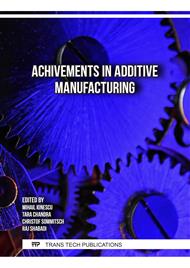[1]
S. Parupelli and S. Desai, A Comprehensive Review of Additive Manufacturing (3D Printing): Processes, Applications and Future Potential, Am. J. Appl. Sci., 16(8) (2019) 244-272.
DOI: 10.3844/ajassp.2019.244.272
Google Scholar
[2]
Y. Tian, K. Chadha, C. Aranas Jr., Laser powder bed fusion of ultra-high-strength 420 stainless steel: Microstructure characterization, texture evolution and mechanical properties, Mater. Sci. Eng. A, 805 (2021) 140790.
DOI: 10.1016/j.msea.2021.140790
Google Scholar
[3]
Y. Tian, R. Palad, C. Aranas Jr., Microstructural evolution and mechanical properties of a newly designed steel fabricated by laser powder bed fusion, Addit. Manuf., 36 (2020) 101495.
DOI: 10.1016/j.addma.2020.101495
Google Scholar
[4]
J. Lewis, J. Pasco, T. McCarthy, M. Harding, C. Aranas Jr., High strain rate and high temperature mechanical response of additively manufactured alloy 625, J. Manuf. Process, 81 (2022) 922-944.
DOI: 10.1016/j.jmapro.2022.07.047
Google Scholar
[5]
K. Chadha, Y. Tian, J. Pasco, C. Aranas Jr., Dual-metal laser powder bed fusion of iron-and cobalt-based alloys, Mater. Charact., 178 (2021) 111285.
DOI: 10.1016/j.matchar.2021.111285
Google Scholar
[6]
Z. Li, C. Cheng, J. Dhillon, S. Kwon, P. Hudon, M. Brochu, Dual-metal laser powder bed fusion of iron-and cobalt-based alloys, Materialia, 28 (2023) 101751.
DOI: 10.1016/j.mtla.2023.101751
Google Scholar
[7]
M. Macias-Sifuentes, C. Xu, O. Sanchez-Mata, S. Kwon, S. Atabay, J. Muniz-Lerma, M. Brochu, Microstructure and mechanical properties of β-21S Ti alloy fabricated through laser powder bed fusion, Prog. Addit. Manuf, 6 (2021) 417-430.
DOI: 10.1007/s40964-021-00181-7
Google Scholar
[8]
S. Bergmueller, L. Gerhold, L. Fuchs, L. Kaserer, G. Leichtfried, Systematic approach to process parameter optimization for laser powder bed fusion of low-alloy steel based on melting modes, J. Adv. Manuf., 126 (2023) 4385-4398.
DOI: 10.1007/s00170-023-11377-2
Google Scholar
[9]
K. Chadha, Y. Tian, P. Bocher, J.G. Spray, C. Aranas Jr., Microstructure evolution, mechanical properties and deformation behavior of an additively manufactured maraging steel, Materials, 13(10) (2020) 2380.
DOI: 10.3390/ma13102380
Google Scholar
[10]
K. Chadha, Y. Tian, J.G. Spray, C. Aranas Jr., Microtextural characterization of additively manufactured SS316L after hot isostatic pressing heat treatment, Met. Mater. Int., 28 (2022) 237-249.
DOI: 10.1007/s12540-021-01046-y
Google Scholar
[11]
A. Seidel, A. Straubel, T. Finaske, T. Maiwald, S. Polenz, M. Albert, J. Näsström, A. Marquardt, M. Riede, E. Lopez, F. Brueckner, E. Beyer, C. Leyens, Added value by hybrid additive manufacturing and advanced manufacturing approaches, J. Laser Appl., 30(3) (2018) 032301.
DOI: 10.2351/1.5040632
Google Scholar
[12]
Y. Tian, K. Nyamuchiwa, K. Chadha, Y. He, C. Aranas Jr., Laser powder bed fusion of M789 maraging steel on Cr–Mo N709 steel: Microstructure, texture, and mechanical properties, Mater. Sci. Eng. A, 839 (2022) 142827.
DOI: 10.1016/j.msea.2022.142827
Google Scholar
[13]
K. Nyamuchiwa, Y. Tian, K. Chadha, L. Jiang, T. Dorin, C. Aranas Jr., Precipitation Behaviour at the Interface of an Additively Manufactured M789–N709 Hybrid Alloy, Acta Metall. Sin-Engl., (2023), in press.
DOI: 10.1007/s40195-023-01558-z
Google Scholar
[14]
C. Brown, T. McCarthy, K. Chadha, S. Rodrigues, C. Aranas Jr., G. Saha, Constitutive modeling of the hot deformation behavior of CoCrFeMnNi high-entropy alloy, Mater. Sci. Eng. A, 826 (2021) 141940.
DOI: 10.1016/j.msea.2021.141940
Google Scholar



